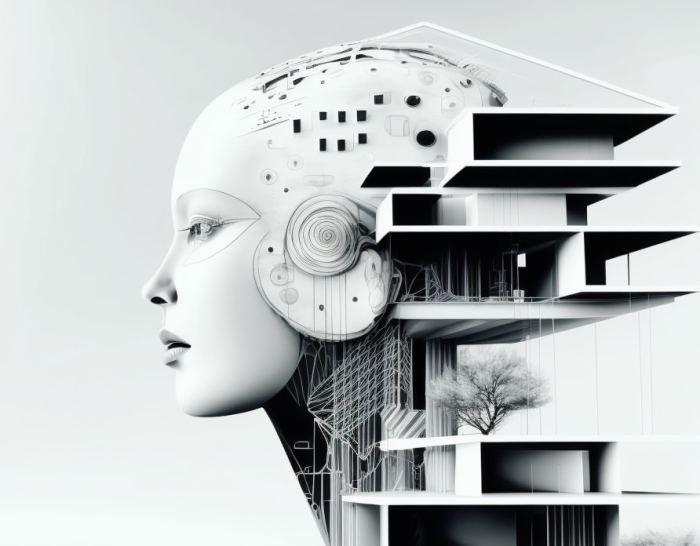How AI is changing the architecture industry sets the stage for this enthralling narrative, offering readers a glimpse into a story that is rich in detail and brimming with originality. With the integration of artificial intelligence into the architectural landscape, innovative changes are reshaping the way buildings are designed, constructed, and sustained.
As AI continues to permeate various aspects of architecture, its impact on sustainable practices, design tools, BIM integration, and construction processes becomes increasingly evident. This exploration delves into the transformative power of AI in revolutionizing the architectural industry.
Overview of AI in architecture

Artificial Intelligence (AI) is revolutionizing the architecture industry by providing innovative solutions to design challenges, streamlining processes, and enhancing creativity. AI algorithms and machine learning are transforming the way architects conceptualize, visualize, and construct buildings.
Current Applications of AI in Architecture
AI is currently being used in architecture for various purposes, such as:
- Generative Design: AI algorithms can generate multiple design options based on specific parameters and constraints, allowing architects to explore a wide range of possibilities efficiently.
- Energy Optimization: AI tools can analyze building designs to optimize energy consumption and improve sustainability, helping architects create eco-friendly structures.
- Pattern Recognition: AI can analyze large datasets to identify patterns and trends in architectural styles, materials, and construction techniques, assisting architects in making informed design decisions.
Benefits of AI in Architectural Design
- Enhanced Efficiency: AI streamlines the design process by automating repetitive tasks, reducing time and effort required for design iterations.
- Improved Creativity: AI tools inspire architects by presenting novel design solutions and unconventional ideas that may not have been considered otherwise.
- Optimized Performance: AI enables architects to optimize building performance through data-driven insights on factors like energy efficiency, structural integrity, and material selection.
AI-powered design tools
AI-powered design tools have revolutionized the architecture industry by enhancing creativity and efficiency in architectural design. These tools leverage artificial intelligence to streamline the design process, allowing architects to explore innovative solutions and optimize their workflows.
Specific AI tools in architecture and their functionalities
- Generative design software: AI algorithms help architects generate numerous design options based on specified parameters, enabling rapid exploration of possibilities.
- Parametric design tools: AI-powered tools create designs that are responsive to changes in parameters, facilitating adaptive and dynamic architectural solutions.
- Machine learning for design analysis: AI algorithms analyze vast amounts of data to identify patterns and trends, aiding architects in making informed design decisions.
Comparison of traditional design methods with AI-powered design tools
- Traditional methods often rely on manual processes and limited design options, while AI tools offer automated solutions and a wide range of design alternatives.
- AI-powered tools can handle complex calculations and iterations with speed and accuracy, surpassing the capabilities of traditional design methods.
- Collaboration and communication among team members are enhanced through AI tools, promoting a more efficient design workflow compared to traditional approaches.
How AI tools enhance creativity and efficiency in architectural design
- AI tools enable architects to quickly explore diverse design options, fostering creativity and innovation in the design process.
- By automating repetitive tasks and optimizing workflows, AI tools free up time for architects to focus on more strategic and creative aspects of their projects.
- Machine learning algorithms can analyze past design data to suggest improvements and optimize future designs, leading to more efficient and effective architectural solutions.
AI in sustainable architecture
Artificial intelligence (AI) is revolutionizing the architecture industry by promoting sustainable practices in various ways. By harnessing the power of AI, architects and designers can create more environmentally friendly buildings that reduce energy consumption, minimize waste, and lower carbon emissions.
Energy-efficient Design
AI-powered design tools can analyze vast amounts of data to optimize building layouts, materials, and systems for maximum energy efficiency. For example, algorithms can simulate different scenarios to determine the most energy-efficient orientation of a building or the best placement of windows for natural light, reducing the need for artificial lighting and heating.
Material Selection and Recycling
AI applications can assist architects in selecting sustainable building materials by considering factors like durability, recyclability, and environmental impact. Additionally, AI algorithms can help identify opportunities for recycling and repurposing materials in construction projects, reducing waste and promoting a circular economy.
Smart Building Management
AI-enabled systems can monitor and control building operations in real-time to optimize energy usage, improve indoor air quality, and enhance occupant comfort. By analyzing data from sensors and IoT devices, AI can adjust heating, cooling, and lighting systems based on occupancy patterns and environmental conditions, leading to significant energy savings and reduced environmental impact.
Environmental Impact Assessment
AI tools can conduct comprehensive environmental impact assessments for architectural projects, considering factors like carbon footprint, water usage, and biodiversity impact. By analyzing this data, architects can make informed decisions to minimize the environmental footprint of their designs and incorporate sustainable practices from the early stages of the project.
AI and Building Information Modeling (BIM)
AI and Building Information Modeling (BIM) have revolutionized the way architectural projects are planned, designed, and executed. The integration of AI with BIM brings a new level of accuracy and efficiency to the architectural industry, enhancing the overall project outcomes.
Enhanced Accuracy and Efficiency
AI plays a crucial role in enhancing the accuracy and efficiency of BIM processes in architectural projects. By utilizing AI algorithms, BIM software can analyze vast amounts of data and information to create more precise 3D models, identify potential design errors, and optimize building performance.
This automation reduces the margin of error and allows architects and engineers to make informed decisions based on reliable data.
Future Implications of AI and BIM Collaboration
The collaboration between AI and BIM holds promising implications for the future of architecture. As AI continues to advance, we can expect even greater integration with BIM tools, leading to more sophisticated design solutions, streamlined project workflows, and improved sustainability practices.
The use of AI in conjunction with BIM will not only enhance the efficiency of architectural projects but also pave the way for innovative and sustainable building designs that meet the evolving needs of society.
AI-driven construction processes

AI is transforming the construction processes in the architecture industry by introducing innovative solutions that optimize efficiency, accuracy, and sustainability. With the integration of AI technologies, construction companies can streamline their operations and achieve better outcomes in building projects.
Optimizing Construction Processes with AI
AI applications in construction processes have been instrumental in enhancing project management, scheduling, and resource allocation. By analyzing vast amounts of data, AI can predict potential issues, optimize workflows, and identify opportunities for improvement. For example, AI-powered drones can survey construction sites, monitor progress, and detect safety hazards in real-time, leading to proactive decision-making.
Challenges and Opportunities of AI in Construction
While AI offers numerous benefits in construction, there are also challenges that need to be addressed. One major concern is the initial cost of implementing AI technologies and the need for specialized training for personnel. However, the long-term benefits, such as reduced construction time, improved safety, and cost savings, outweigh these challenges.
Additionally, AI has the potential to revolutionize the construction industry by enabling the development of smart cities, sustainable buildings, and cutting-edge infrastructure projects.
Conclusion
In conclusion, the infusion of AI into the architecture industry is not just a trend but a fundamental shift that promises to redefine the future of architectural design and construction. With AI-driven tools and processes paving the way for greater efficiency, creativity, and sustainability, the architectural landscape stands on the brink of a new era.
Essential FAQs
How is AI impacting traditional design methods in architecture?
AI is transforming traditional design methods by providing architects with tools that enhance creativity, streamline processes, and generate innovative solutions at a faster pace.
What are some challenges associated with implementing AI in construction processes?
Challenges may include initial investment costs, data privacy concerns, and the need for upskilling the workforce to effectively utilize AI technologies.
How does AI contribute to sustainable architectural practices?
AI aids in optimizing energy consumption, material usage, and building performance through data analysis, simulation, and predictive modeling, thereby promoting sustainability.
What are the benefits of integrating AI with Building Information Modeling (BIM)?
The integration enhances the accuracy of project data, improves collaboration among stakeholders, and automates tedious tasks, leading to more efficient project delivery.





